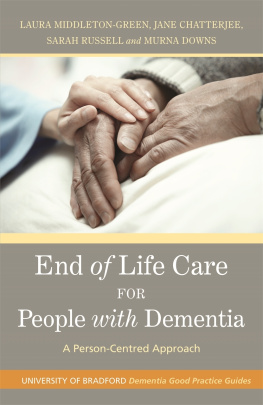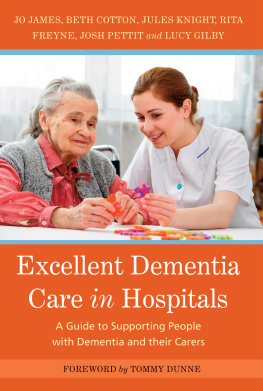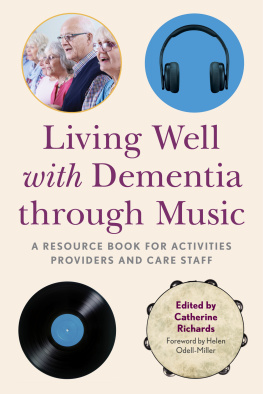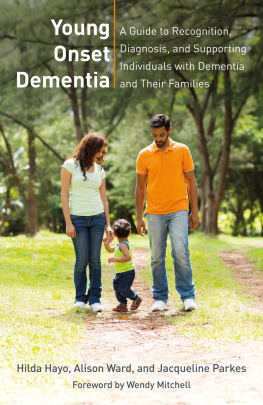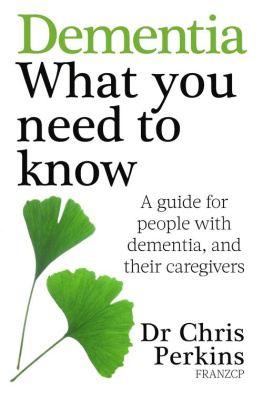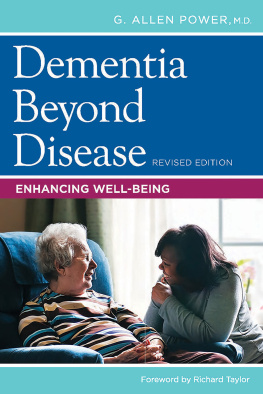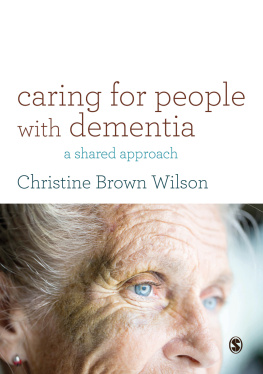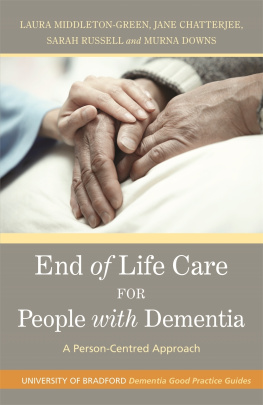A POSITIVE ENVIRONMENT?
PHYSICAL AND SOCIAL INFLUENCES ON PEOPLE WITH SENILE DEMENTIA IN RESIDENTIAL CARE
This book is dedicated to Cliff, Katie and Jo
First published 1993 by Ashgate Publishing
Reissued 2018 by Routledge
2 Park Square, Milton Park, Abingdon, Oxon OX14 4RN
711 Third Avenue, New York, NY 10017, USA
Routledge is an imprint of the Taylor & Francis Group, an informa business
Copyright Ann Netten, 1993
All rights reserved. No part of this book may be reprinted or reproduced or utilised in any form or by any electronic, mechanical, or other means, now known or hereafter invented, including photocopying and recording, or in any information storage or retrieval system, without permission in writing from the publishers.
Notice:
Product or corporate names may be trademarks or registered trademarks, and are used only for identification and explanation without intent to infringe.
Publishers Note
The publisher has gone to great lengths to ensure the quality of this reprint but points out that some imperfections in the original copies may be apparent.
Disclaimer
The publisher has made every effort to trace copyright holders and welcomes correspondence from those they have been unable to contact.
A Library of Congress record exists under LC control number: 92044396
Typeset at the PSSRU, University of Kent at Canterbury
ISBN 13: 978-1-138-60840-5 (hbk)
ISBN 13: 978-1-138-60843-6 (pbk)
ISBN 13: 978-0-429-46341-9 (ebk)
Contents
My thanks are due to many people without whose advice, practical assistance and support this book would not have been possible. During the study Ann Clewer has provided invaluable support and advice, particularly of a statistical nature, and David Challis has been an excellent source of advice, obscure references and brainstorming sessions, especially at the start of the study. My thanks are also due to Bob Woods, who undertook the thankless task of external examiner, and Bleddyn Davies, whose support and encouragement have enabled the book to be completed.
If it had not been for the support of the Dora Harvey Memorial Trust the study would never have been initiated. The grant from this trust enabled me to undertake the doctoral programme: the fortuitous arrival of my application and this grant on the same desk on the same day will never cease to amaze me. Financial support was also received at a time of crisis from the Alzheimers Disease Society. The cost of printing the instrumentation for the study exceeded the money available by (what seemed at the time) a huge sum. I shall always be grateful to the Society for their positive and speedy response to a request for help.
The data collection was the result of a lot of work from many people who were astoundingly co-operative in the face of what must have seemed like constant misrepresentation about the amount of time and effort required. In particular, the staff of the fifteen homes involved in the study (two pilot homes and thirteen in the main study) put in an enormous amount of time, effort and enthusiasm. The managerial staff in the social services departments were also unfailingly co-operative and helpful. My thanks are also due to the two social service managers who were prepared to give up their time for interview at the pilot stage.
Before I had access to a word processor, or any of the other benefits associated with being an employee of the PSSRU, several people provided secretarial help: Su Bellingham typed the questionnaires, Sandy Meggs typed letters and early versions of the literature review and pilot study, and Lucy Holley was a tremendous help in transferring the data on to the computer. Latterly, Anita Whitley has contributed with so many varied tasks (such as typing impossible tables, chasing references, photocopying and proof-reading) that I dare not try to identify them all for fear of omitting some. Jane Dennett has worked her customary miracle in converting the text into camera-ready copy and subediting.
I am grateful to Alan Sivell, who produced the diagrams for first appeared in Ann Netten, The effect of design of residential homes in creating dependency among confused elderly residents: a study of elderly demented residents and their ability to find their way around homes for the elderly in the International Journal of Geriatric Psychiatry, 1989, volume 4, pages 143-153 and are reprinted by kind permission of John Wiley & Sons Ltd. Moreover, Professor Rudolf Moos was most kind in giving permission to reproduce a table from the SCES manual.
Richard von Abendorff has been a great help in playing devils advocate when discussing concepts and ideas. In the final tortuous stages of writing, rewriting and editing, Ann Clewer, David Challis, Cliff Netten, Helen Chamley and Jeni Beecham have been an enormous help in commenting on draft chapters. They have helped identify logical omissions, incomprehensible English and the more glaring grammatical errors. Justin Keen, Robin Lawson, Charlotte Salter and Justine Schneider have been most helpful in reading through later versions for sense and nonsense, and providing valuable comments on the contents.
The study would have been impossible to undertake in the absence of an effective, supportive, informal network. I shall not try to list all the people who have helped in times of crisis, for fear of leaving someone out. However, I shall never forget the dry run of the upgrading seminar with mathematical consultant Mary McHale, media consultant Phil McHale and bored onlooker Cliff Netten. Lindsay Franklin, Mary McHale and Sherry Wilkin were a tremendous help in the early stages of child care arrangements. Gail Bayliff has been a reliable, flexible and uncritical mothers help and friend. Only another working mother can truly appreciate the importance of that contribution. Last, but by no means least, Cliff, Katie and Jo have had to put up with a lot. Katie and Jo have been patient and understanding beyond their years and if it hadnt been for Cliffs contribution we would probably all be suffering from malnutrition.
Ann Netten
July 1992
Like the prevalence of the disease itself, interest in residential care of people with senile dementia is bound to grow. While the option of domiciliary care may be achievable for increasingly high levels of disability, for other groups of elderly and disabled people there is a limit to the endurance of relatives and friends of people with dementia. Their demands are such that support provided by community-based social services is necessarily limited, and institutional care of some form frequently becomes the only viable option. It is important, both for those in receipt of care and for those who can no longer cope with the burden of care, that these institutions should provide the most beneficial environment possible.
The Wagner review of residential care took as a point of principle that:
Living in a residential establishment should be a positive experience ensuring a better quality of life than the resident could enjoy in any other setting (Wagner, 1988, p.114).
But is it possible to determine if residents with senile dementia are having a positive experience? Is it possible to identify that they are enjoying a better quality of life than they could otherwise? Before such questions can be addressed there needs to be an understanding of the impact of different settings or environments on elderly people with senile dementia. In particular there needs to be an understanding of the effect of the physical and social environment of the homes on the well-being of the confused residents.



